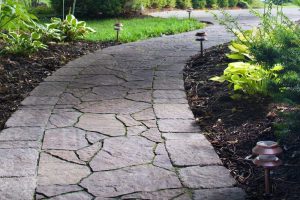
Choosing the Right Materials for Your Walkway
When it comes to walkway materials, the options are seemingly endless. It’s important to select materials that not only complement the style of your home but also provide durability and functionality. Let’s explore some popular choices:
-
- Pavers: Pavers are a versatile and affordable option for walkways. Made from concrete or natural stone, they come in a wide variety of shapes, sizes, and colors, allowing you to create a customized look. Pavers require minimal maintenance and are resistant to cracking, making them a popular choice among homeowners.
- Flagstone: Flagstone walkways exude a timeless and natural beauty. These flat, irregularly shaped stones can be arranged in various patterns, adding a rustic charm to your landscape. While flagstone requires more maintenance than pavers, it offers a unique and visually stunning walkway option.
- Natural Stone: Natural stone walkways, such as bluestone or limestone, provide an elegant and sophisticated look to any home. These durable stones offer a range of colors and textures, allowing you to create a truly unique walkway that complements your landscape.
- Brick: Brick walkways are a classic choice that adds a touch of traditional charm to your home. With their warm hues and timeless appeal, brick walkways can enhance the overall aesthetic of both modern and traditional homes.
Design Tips for the Perfect Walkway
Now that you’ve chosen the materials, it’s time to focus on the design elements that will make your walkway truly stand out. Here are some key considerations to keep in mind:
Compatibility with Your Home’s Architecture
Your walkway should seamlessly blend with the architecture and style of your home. Consider the overall design and character of your house. If you have a modern home, opt for clean lines and geometric shapes. For more traditional or rustic homes, curved or meandering walkways can add a touch of charm.
Straight vs. Curved Walkways
The shape of your walkway can greatly impact the overall aesthetic and mood of your landscape. Straight walkways tend to convey a formal and direct approach, while curved or meandering paths create a more inviting and relaxed atmosphere. Consider the layout of your outdoor space and choose a shape that best complements the flow of your landscape.
Width of the Walkway
While functionality is key, it’s important to consider the width of your walkway to accommodate foot traffic comfortably. A wider walkway, typically around four to six feet, allows for pedestrians to walk side by side and creates a more spacious and welcoming feel. Additionally, a wider walkway provides an opportunity to create a gathering area near the entrance of your home.
Landscaping Along the Walkway
To enhance the visual appeal of your walkway, consider incorporating landscaping elements along its edges. Colorful plants, flowers, and shrubs can create a beautiful natural border and add vibrancy to your walkway. Opt for a mix of evergreen and deciduous plants for a year-round display of colors and textures.
Illumination for Safety and Charm
Proper lighting can transform your walkway into an enchanting feature, while also ensuring safety during nighttime. Incorporate subtle LED landscape lighting along the edges of your walkway to guide visitors and add a touch of charm to your outdoor space. Lighting not only enhances the beauty of your walkway but also invites guests for a leisurely stroll on a beautiful evening.
Walkway Design Trends
As with any design element, walkway design trends evolve over time. Here are a few popular trends that can add a modern twist to your walkway:
-
- Acid Staining and Stamped Concrete: Acid staining and stamping concrete have gained popularity as cost-effective methods to enhance the appearance of regular poured concrete. Acid staining provides a range of color options and can be applied to existing concrete surfaces. Stamped concrete mimics the look of natural materials, such as brick or stone, and offers a more affordable alternative.
- Dyeing Concrete: Concrete dyeing allows for a wide range of color options, making it a versatile choice for walkways. This method is best suited for large-scale projects and is often mixed into the concrete during the ready-mixing process. Dyeing concrete is best left to professionals due to its complexity.
- Color Coordination: When selecting colors for your walkway, consider the color palette of your home’s exterior. Opt for earth-tone colors that complement the existing structures. For pathways, choose natural colors that blend seamlessly with the surroundings, creating a harmonious and cohesive look.
- Sealing for Protection: To maintain a vibrant and long-lasting appearance, apply a commercial sealer to your walkway after completion. This not only enhances the color but also protects the materials from weathering and mold buildup.
Planning and Cost Considerations
Before embarking on your walkway project, there are a few planning and cost considerations to keep in mind:
-
- Budget: Determine your budget for the project as it will dictate the materials and design options available to you. Consider the long-term maintenance costs when selecting materials.
- Shade and Weather Conditions: Take into account the amount of shade your walkway receives. In shady areas, moss and mildew can accumulate on stone and concrete surfaces, creating a slippery and hazardous condition. Choose materials that are suitable for your specific climate and lighting conditions.
- Home Construction and Design: Consider the style and color palette of your home when designing your walkway. Select materials and colors that complement the existing structures without overpowering them. Earth tones often work well with traditional building materials.
- Real Estate Value: A well-designed and executed walkway can enhance the value of your home. However, it’s crucial to ensure that the project is worth the potential cost. Consult with a landscape designer to assess the potential return on investment.
We Provide Patio, Walkway, and Driveway Design and Installation Services
Patios, Walkways, and Driveways offer property owners a valuable opportunity to create inviting and functional outdoor living spaces. We can provide guidance on factors such as patio size, layout, and material options, taking into account the existing landscape, architectural style, and intended use of the space.
> Learn More
Designing the perfect walkway for your home is an opportunity to showcase your personal style and enhance the overall aesthetic of your property. By carefully selecting materials, considering design elements, and planning according to your budget, you can create a walkway that not only adds curb appeal but also provides a warm and inviting entrance to your home. Remember to consult with professionals and conduct thorough research to ensure that your walkway project meets your expectations and contributes to the value of your home. Enjoy the journey of creating a beautiful and functional walkway that will be enjoyed for years to come.
Contact Us (859-781-0677) for More Information!
—

About Davis Landscaping
Davis Landscape Design & Installation has been providing landscaping services to customers in Northern Kentucky and Greater Cincinnati since 1965! We know that the landscape design process can be overwhelming, so we work with you tirelessly to better understand your vision. At Davis Landscape Design & Installation, we’re on your team and we know how to listen and deliver.
